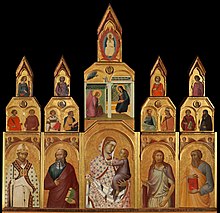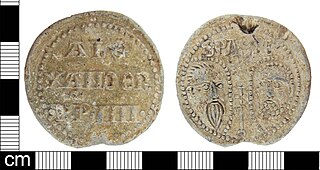
Guido Tarlati (died 1327) was a lord and Bishop of Arezzo.

Guido Tarlati (died 1327) was a lord and Bishop of Arezzo.
Tarlati was a member of the leading Ghibelline family of Arezzo, who were centered in their fief at Pietramala. In Arezzo, two aristocratic factions contended for domination, the Verdi and the Secchi, and when the latter gained control they had their leader, Guido Tarlati, Archpriest of the Pieve of S. Maria Aretina, elected bishop in 1312. [1]
The electoral meeting following the death of Bishop Ildebrandino (1289–1312) chose to proceed by the "Way of compromise" and elected two persons, both Canons of the cathedral, to make the selection. They chose Guido, and the rest of the electoral meeting concurred and ratified the election. Guido immediately accepted, and procurators were chosen to carry the record of the election to the Papal Court at Avignon. Pope Clement V appointed a committee of three cardinals to look into the election and the character of the candidate, and when a favorable report was received, he issued a confirmation of the election of Bishop Guido on 7 July 1312. [2]
He embarked on an activist program, building a wall around the city, and creating a new silver and copper currency. [3] His program also included military conquest; on his funeral monument appear the names of: Lusignano, Chiusi, Fronzoli, Castel Focognano, Rondina, Bucine, Caprese, Lacerina, and Monte Sansovino.

The gilded three-story altarpiece, the Arezzo (or Aretine or Tarlati) Polyptych , was commissioned in 1320 by Bishop Tarlati for the Santa Maria della Pieve in Arezzo. [4] At its centre is the Madonna (draped in a magnificent ermine-lined robe) and Child, flanked (from left to right) by the saints Donatus (Arezzo's patron saint), John the Evangelist, John the Baptist, and Matthew. [4] [5]
In 1321 he was declared seignior of Arezzo, a position he held until his death. During his administration he supported Uguccione della Faggiola and Castruccio Castracani, lords of Lucca, in their wars against Florence.
Tarlati also expanded the territories of Arezzo, and in 1323, with the collaboration of Francesco I Ordelaffi (Ghibelline lord of Forlì), he conquered Città di Castello. Arezzo's expansion caused, however, the deterioration of the relations with the Papal States, ending with the excommunication of Tarlati by Pope John XXII.
On 19 June 1325, Pope John XXII raised the commune of Cortona in the diocese of Arezzo to episcopal rank, as a reward for the fidelity of its Guelph populace. The diocese of Arezzo was greatly diminished in size, and Bishop Guido's spiritual powers terminated. [6] The papal bull refers to the once Bishop Guido, indicating that he had already been deposed. A month later, on 20 July 1325, Guido Tarlati de Petramala was excommunicated. Bishop Guido was replaced by an Apostolic Administrator, Boso Ubertini, the Provost of Arezzo. Boso was named Bishop of Arezzo on 5 December 1326. But Tarlati hindered Boso from carrying out his functions. [7]

Tarlati's prestige as the leader in Tuscany of the Ghibelline party, however, was so high that German emperor Louis IV wanted to receive from him the Iron Crown. The coronation took place in Milan on 31 May 1327.
A short time before his death Tarlati reconciled with the Pope.[ citation needed ]
According to Giorgio Vasari the tomb commissioned by Guido's brother, the condottiero Pier Saccone Tarlati di Pietramala, was designed by Giotto (although this is disputed), who recommended to Pier Saccone the Sienese sculptors Agnolo da Ventura and Agostino di Giovanni to execute it. [8] It is located in the Cathedral of Arezzo.

Pope Alexander IV was head of the Catholic Church and ruler of the Papal States from 12 December 1254 to his death.

Arezzo is a city and comune in Italy and the capital of the province of the same name located in Tuscany. Arezzo is about 80 kilometres southeast of Florence at an elevation of 296 metres (971 ft) above sea level. As of 2022, the population was about 97,000.

Città di Castello ; "Castle Town") is a city and comune in the province of Perugia, in the northern part of Umbria. It is situated on a slope of the Apennines, on the flood plain along the upper part of the river Tiber. The city is 56 km (35 mi) north of Perugia and 104 km (65 mi) south of Cesena on the motorway SS 3 bis. It is connected by the SS 73 with Arezzo and the A1 highway, situated 38 km (23 mi) west. The comune of Città di Castello has an exclave named Monte Ruperto within Marche.

Sansepolcro, formerly Borgo Santo Sepolcro, is a town and comune founded in the 11th century, located in the Italian Province of Arezzo in the eastern part of the region of Tuscany.

The Archdiocese of Fermo is a Latin archdiocese of the Catholic Church in northern Italy, with its seat in the city of Fermo, Marche. It was established as the Diocese of Fermo in the 3rd century, and elevated to an archdiocese by Pope Sixtus V on 24 May 1589. The archiepiscopal seat is Fermo Cathedral. The current archbishop is Rocco Pennacchio.

The Roman Catholic diocese of Sansepolcro was a Latin rite see in Tuscany, central Italy. It was erected in 1515, as the Diocese of (Borgo) Sansepolcro (Italian), though difficulties prevented the appointment of a bishop until 1520. On 30 September 1986, the diocese was suppressed and united with the Diocese of Arezzo and the Diocese of Cortona to form the Diocese of Arezzo-Cortona-Sansepolcro.

The Diocese of Macerata-Tolentino-Recanati-Cingoli-Treia is a Latin diocese of the Catholic Church in Italy. It is a suffragan of the Archdiocese of Fermo.

The Archdiocese of Pisa is a Latin Church metropolitan see of the Catholic Church in Pisa, Italy. It was founded in the 4th century and elevated to the dignity of an archdiocese on 21 April 1092 by Pope Urban II. The seat of the bishop is the cathedral of the Assumption in the Piazza del Duomo.

The Diocese of Volterra is a Latin diocese of the Catholic Church in Tuscany, central Italy. It is a suffragan of the Archdiocese of Pisa.

The Diocese of Gubbio is a Latin diocese of the Catholic Church in the province of Perugia, in Umbria, central Italy.

The diocese of Cortona was a Roman Catholic ecclesiastical territory in central Italy, which existed from 1325 to 1986. It was immediately subject to the Holy See.

The Diocese of Arezzo-Cortona-Sansepolcro is a Latin diocese of the Catholic Church. It has existed since 1986. In that year the historic diocese of Arezzo was combined with the diocese of Cortona and the diocese of Sansepolcro, the enlarged diocese being suffragan of the archdiocese of Florence.

The Diocese of San Miniato is a Latin diocese of the Catholic Church in Tuscany. It is a suffragan of the archdiocese of Florence.

The former Italian Catholic Diocese of Chiusi-Pienza, in Tuscany, existed until 1986. In that year it was united into the Diocese of Montepulciano-Chiusi-Pienza. The Diocese of Chiusi (Clusinus) was at first immediately subject to the Holy See, but was made a suffragan of archdiocese of Siena by Pope Pius II. From 1459 to 1986, it was a suffragan of the archdiocese of Siena.

Pier Saccone Tarlati di Pietramala (1261–1356) was an Italian condottiero from Pietramala d'Arezzo in the Val d'Arno, a rocca that controlled the mule track between his native town of Arezzo and Anghiari. Pietramala was the seat of the powerful family of the Tarlati, who came to prominence in the strife following Arezzo's decisive defeat at Campaldino (1289) as heads of the Ghibelline "Secchi" faction of Arezzo. Pier Saccone's brother was Guido Tarlati, bishop and signore of Arezzo.

Arezzo Cathedral is a Roman Catholic cathedral in the city of Arezzo in Tuscany, Italy. It is located on the site of a pre-existing Palaeo-Christian church and, perhaps, of the ancient city's acropolis.

The Roman Catholic Diocese of Ortona a Mare e Campli was a Roman Catholic diocese in Italy, located in the city of Ortona, in the Province of Chieti in the Italian region of Abruzzo. In 1834, it was united with the Archdiocese of Lanciano to form the Archdiocese of Lanciano.

The Diocese of Montalcino was a Roman Catholic diocese located in the town of Montalcino to the west of Pienza, close to the Crete Senesi in Val d'Orcia in Tuscany, Italy. In 1986, it was suppressed and united with the Diocese of Colle di Val d'Elsa and the Archdiocese of Siena to form the Archdiocese of Siena-Colle di Val d'Elsa-Montalcino.
The following is a timeline of the history of the city of Arezzo in the Tuscany region of Italy.